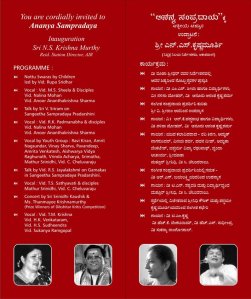The death of N. Kotiswara Aiyar was announced in The Hindu dated October 21 and the headline read ‘Death of a prominent musician.’ In keeping with the manner of reporting in those days, the news item gave details of his passing. “Till last Thursday he was all right and that afternoon, had a sudden attack of something like paralysis of the throat muscles which prevented him from taking any food. Last Saturday, he was admitted into the General Hospital. He passed away at 10.50 a.m. this morning.”
This was followed by a detailed obituary by E. Krishna Aiyar, written in his capacity as secretary, The Music Academy. EK wrote ‘amidst us we have very few composers of the real creative type. A Papanasam Sivan here and a Muthiah Bhagavatar there are some of the exceptions of the rule. Vidwan Kotiswara Aiyar was one such exception.” The article later traced Kotiswara Aiyar’s illustrious lineage, for he was the grandson of Kavi Kunjara Bharati, the well-known poet who composed songs compiled as Perinba Keertanas and Skanda Purana Keertanas. EK wrote that Kotiswara Aiyar learnt music from Ramanathapuram Poochi Srinivasa Iyengar. Other sources have had it that he also learnt music from Poochi Iyengar’s guru Patnam Subramani Iyer.
Academic pursuits
According to EK, Kotiswara Iyer ‘took his BA degree after undergoing his college course in Pudukottah and Trichinopoly.’ On graduation, he was employed at the Inspector General of Police office in Madras and later as a translator at the Madras High Court. In between, he also served as an English teacher in the Venkataramana Ayurveda Dispensary and Sanskrit College. It was only later in life that Kotiswara Aiyar’s talents as a composer flowered. It was also owing to the influence of what were then burning topics in the field of music.
The first concerned the vivadi or dissonant scales, of which there are 40 in number in the Melakarta system. While Tyagaraja had handled a few in his songs and Muthuswami Dikshitar had handled almost all of them as per the raganga raga scheme (which unlike the Melakarta scheme did not have straight scales for all the 72 mother ragas), it was the considered view of many that the vivadis were not musical.
Madurai Ponnuswami Pillai, the eminent nagswaram vidwan, even penned a treatise titled ‘Poorvika Sangita Unmai’ which denied the existence of the 40. It was also considered inauspicious to sing vivadi ragas. This was also the time when the absence of Tamil songs was being felt.
A mighty task
Kotiswara Aiyar decided to compose songs in all 72 melakartas, vivadi or not. In the words of Professor Sambamurthy, “the composer took upon himself a mighty task and achieved the ideal. To attempt pieces in unfamiliar ragas is a difficult task. He has to think out the new ragas, form a picture in his mind and determine its jeeva, nyasa swaras and raga ranjaka prayogas to put in his compositions. The music world will realise the amount of time and thought this illustrious composer must have bestowed in these kritis.”
Beginning with ‘Ma Madhura Sarasa’ in the raga Ganamurthy, Kotiswara Aiyar went on to compose songs in all the 72 ragas, all of them in Tamil. The compilation of the shuddha madhyama raga songs was brought out as the Kandaganamudam in 1932. In its preface, the composer expressed the desire that just like Telugu, Tamil should be given importance in concerts.
The work received praise from Dwaram Venkataswami Naidu, Kirtanacharya C.R. Srinivasa Iyengar, U. Ve. Swaminatha Iyer, T.S. Sabesa Iyer, Harikesanallur Muthiah Bhagavatar, Tiger Varadachariar and Papanasam Sivan. T.L. Venkatarama Iyer, reviewing it for The Hindu (October 12, 1932) noted that Kotiswara Aiyar ‘had made the first comprehensive attempt to compose kirtanas in all melas. The scientific value of his kirtanas is of a high order and this publication is a landmark.”
The second volume, comprising the prati madhyama ragas, was brought out in February 1938. On this occasion, an overwhelmed Parur Sundaram Iyer wrote that his eyes had been opened to the possibilities in the vivadi ragas. He praised Kotiswara Aiyar for making a bold attempt to compose in these ragas with the vivadi or dissonant notes used in full. This was a marked departure from earlier composers who minimised the vivadi effect while using these ragas.
It was as though Kotiswara Aiyar’s task on earth was done for he passed away the same year. On October 25, 1938, two lawyers N. Ramakrishnan and K. Rajagopalan in their tribute to Kotiswara Aiyar in The Hindu, wrote that ‘it behoves all lovers of our music to confer and devise means to perpetuate the memory of this great star composer.’ That came to reality when artists such as S. Rajam made it their life’s mission.
The author can be contacted at srirambts@gmail.com

 Focused on Diksitar krithis .. held at Gayana Samaja.
Focused on Diksitar krithis .. held at Gayana Samaja.